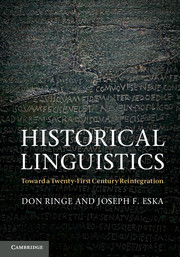Book contents
- Frontmatter
- Contents
- Figures
- Tables
- Preface
- Acknowledgments
- Introduction
- 1 The nature of human language and language variation
- 2 Language replication and language change
- 3 Language change in the speech community
- 4 Language contact as a source of change
- 5 Sound change
- 6 The evolution of phonological rules
- 7 Morphology
- 8 Morphological change
- 9 Syntactic change
- 10 Reconstruction
- 11 Beyond comparative reconstruction
- Appendix: Recovering the pronunciation of dead languages: types of evidence
- References
- General index
- Index of languages and families
11 - Beyond comparative reconstruction
Subgrouping and “long-distance” relationships
Published online by Cambridge University Press: 05 February 2013
- Frontmatter
- Contents
- Figures
- Tables
- Preface
- Acknowledgments
- Introduction
- 1 The nature of human language and language variation
- 2 Language replication and language change
- 3 Language change in the speech community
- 4 Language contact as a source of change
- 5 Sound change
- 6 The evolution of phonological rules
- 7 Morphology
- 8 Morphological change
- 9 Syntactic change
- 10 Reconstruction
- 11 Beyond comparative reconstruction
- Appendix: Recovering the pronunciation of dead languages: types of evidence
- References
- General index
- Index of languages and families
Summary
Once we have reconstructed the protolanguage of a family, there are further uses to which we can put the information we have retrieved. This chapter will give a quick overview of some of those further investigations. It will be seen that they vary greatly in feasibility and in the scientific validity of their results.
Subgrouping of languages
When we have reconstructed a significant part of a proto-lexicon and proto-grammar from a set of attested languages by rigorous phonological reconstruction, we can be certain that those languages are related, because we have recovered part of the structure of their common ancestor. But that is only a small part of the languages’ prehistory. We would also like to recover as much information as possible about the descent of each language (as defined at the beginning of Chapter 10). It will often turn out that a subset of the attested languages shared a line of descent before beginning to diversify; that is, they were still a single language for some time after the initial diversification of the language family. In that case we should be able to reconstruct from them a protolanguage which is a daughter of the protolanguage of the whole family. If we represent linguistic diversification by the diverging lines, or “edges,” of a tree diagram, with each protolanguage as a node from which diversifying daughters radiate, we have the familiar “family tree,” or Stammbaum, representing descent relationships among the daughter languages (though not other aspects of their history and relationships).
- Type
- Chapter
- Information
- Historical LinguisticsToward a Twenty-First Century Reintegration, pp. 256 - 280Publisher: Cambridge University PressPrint publication year: 2013



